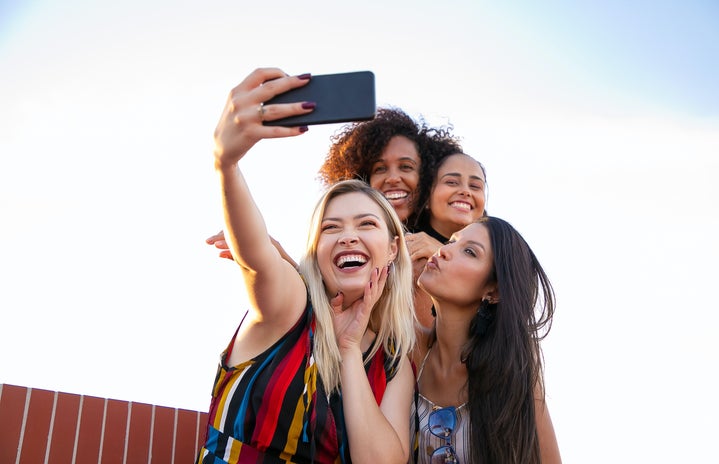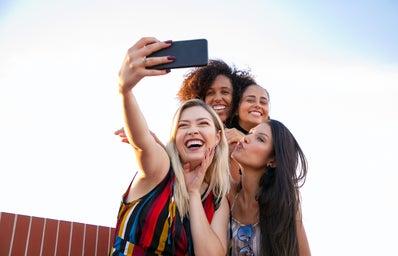As I scrolled through TikTok and watched the umpteenth “clean-girl makeup” tutorial, it recently occurred to me that I had witnessed a mass cultural inversion from glamorized insincerity to falsified authenticity. This trend seemed pervasive in every subsect of life. Heavy-contours and foundation had been swapped for more minimalist, “no-makeup, makeup” looks (to show off your natural beauty). Skinny jeans and leggings had been rejected for baggy mom jeans and yoga pants (“because I care more about comfort than fashion, anyway!”). And Instagram feeds had been rebranded from rows of pristine selfies to blurry photos of whatever junk was lying around the house (“to appreciate the little things in life!”).
On an implicit level, this shift seemed to make sense. We can historically mark dozens of occasions when society has oscillated from one extreme to the other, whether it be through the hairsprayed sixties to the bed-head look of the seventies, or the straight to hourglass switch in dress shapes after WWII. Trends come and go, and we ride the wave of consumerist desire without bothering to question our need to stay afloat.
But what interests me more than the trends themselves is the sudden repulsion of all things remotely artificial (“Why are you wearing so much makeup? You’re a catfish”). In a digital age where your virtual self is a conduit of the reality you wish to embody, performance for the sake of performance is seen as tacky and overdone (“She’s such a pick-me”). Models must now post pictures of their pizza slices, because they know their dieting regimens don’t fit into the average-scroller’s idea of a ‘realistic’ meal (no matter how realistic dieting may be for them).
There is an idea to strive and normalise our seemingly boring lives. If we can romanticise cleaning our bedrooms, taking the dog out for a walk, and having a bath, then we’ll truly be the main character. And so the standards for the “ideal” life have been lowered, creating a new prototype that is, ostensibly, more attainable.
You see, I find this general disdain for our 2016-selves vaguely amusing (afterall, this was only half a decade ago). It reminds me of that fleeting Instagram vs Tiktok debate. Those on Instagram refuse to download Tik Tok because they think it’s cringeworthy, and those on Tiktok see Instagrammers as pick-me’s with tasteless humour (and yes, I’m aware the vast majority of people use both; I’m drawing caricatures for comparison).
Both groups believe themselves to be different and superior, but the truth is history will see these apps as practically indistinguishable. These platforms both take trends, whether it be an image (i.e. smart SpongeBob) or nowadays, an audio sound (“a negroni…sbagliato…” you know the rest) which the creator can overlay with their own #relatable text, providing entertainment for millions. And this is not a critique of the humour itself—I get it, it’s funny. I would actually argue that Gen Z is the funniest generation alive (call me biased). But the difference, or lack thereof, between these two platforms serves my point.
Folks, we’re not switching from flip phones to iPhones; we’re moving from IOS 6 to IOS 7. Is this new software prettier, more efficient, and by all metrics, superior? Absolutely. But functionally, it serves no greater purpose than to act as a stepping stone for what’s to come. In the same way software updates stun users for the first three days but are completely forgotten a month later, these cultural shifts from one extreme to another are not nearly as progressive as we’d like to believe. This means that while you may laugh at your millennial friends for their vintage memes, and you may smile with fondness at your parents’ dad-jokes, the differences in humour are negligible, and one day you too will become outdated.
Corporations have monopolised this mass mentality, pushing this idea that you too, can be AuthenticTM with the download of a single app. You see, my reaction to BeReal was almost identical to my discovery of Snapchat streaks a decade ago:
But what’s the point?
Because both apps serve no purpose. They are displays of elitism used to calculate your worth, based on some arbitrary metric decided #ForYou by the conglomerate gods above. Your friendships are only as meaningful as the number of days your streaks have gone unbroken. Your life is only as interesting as the number of interesting moments you’ve captured on camera.
BeReal has somehow managed to convince teenagers that despite retaking seven versions of that selfie (“Because I didn’t like the first one”), and despite deliberately waiting beyond the two-minute limit to capture that evening you’re out with friends (“Want to be in my BeReal?”), that yes, you are sincerely engaging with the world around you. Authenticity is a commodity to be purchased. OR, you can download this app dedicated to the promotion of your authentic well-being, very convincingly titled BeReal.
The mid-2010’s were fake, sure–but I would argue we were living in a socially sanctioned era of performance (nobody was questioning whether or not you really had dog-ears when you used the puppy filter on Snapchat). This au-naturale era we’re living in has created an illusion of transparency, but don’t let that fool you– because this lifestyle is no more attainable than its 2016 counterpart. So the next time you scroll through Instagram and feel insecure after seeing all those exciting, chic-effortless lives being lived, remind yourself that these people exist beyond their social media pages, and the insecurity they feel while posting these images is just as real as yours.


